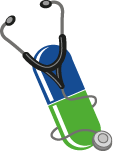Key messages for hospital managers / administrators
These key messages were developed as part of a toolkit aimed at promoting prudent use of antibiotics in hospitals and other healthcare settings through dissemination of evidence-based educational and information materials.
Download

Tasks
1. Your tasks related to improving antibiotic use include [31,42,56,71,75]:
a) Establishing a multidisciplinary team for your hospital antibiotic stewardship programme. This team should include infectious disease specialists, clinical microbiologists and pharmacists, and should receive dedicated funding and resources;
b) Supporting implementation of antibiotic guidelines and infection prevention and control measures;
c) Implementing targeted educational activities and training that:
i. optimise the diagnostic and therapeutic management of patients;
ii. ensure that antibiotic stewardship recommendations are followed;
iii. address behavioural factors shaping misuse of antibiotics;
iv. enhance prevention and control of healthcare-associated infections and the spread of antibiotic-resistant bacteria.
d) Promoting prescribers and antibiotic stewardship team leaders to collaborate and conduct proactive audit and feedback.
e) Setting quality indicators and quantity metrics to measure the progress and outcomes of the antibiotic stewardship programme;
f) Ensuring that antibiotics listed in hospital formulary are always available; and
g) Ensuring that prudent antibiotic use and prevention of antibiotic resistance are “priority action areas” in your hospital’s annual plan.
Things you should know
2. Antibiotic stewardship programmes, together with infection prevention and control practices, can increase patient safety and quality of care and reduce hospital costs across all services by improving how antibiotics are used, as well as by decreasing C. difficile infections and other adverse events [19,42].
Example:
Implementing antibiotic stewardship programmes has resulted in [46]:
- Reducing antibiotic consumption by 20%,
- Reducing the incidence of hospital-acquired infections,
- Shortening the length of hospital stays, and
- Reducing antibiotic costs by 33%.
3. Infectious disease specialists, clinical microbiologists, and clinical pharmacists are all key leaders in the antibiotic stewardship team [56,76].
4. Many prescribers and other healthcare professionals believe their training in prudent antibiotic use is insufficient. They are asking for local antibiotic guidelines, specific education and antibiotic stewardship teams [25,27].
5. Clinicians are responsible for prescribing and they must be fully engaged in shared decision-making with the antibiotic stewardship team [42].
6. For antibiotic stewardship teams to be successful, they need the active support of other key professionals in hospitals, such as infection prevention and control professionals, emergency department practitioners, hospital epidemiologists, nurses and IT staff [42,77].
7. Improving antibiotic use in the emergency department can lead to better antibiotic use across the entire organisation, because the emergency department is a common point of entry to the inpatient setting [77].
8. Both restrictive measures and persuasive measures can decrease antibiotic use [19,43,54,56]:
- Restrictive measures include pre-approval and post-authorization decisions for specific antibiotics;
- Persuasive measures include proactive audit and feedback by infectious diseases physicians, microbiologists and pharmacists.
9. Antibiotic guidelines and regular educational sessions and rounds improve how physicians manage infections [78].
- Certain structural strategies can improve antibiotic prescribing and patient outcomes. These include [54,79-81]:
- computer-supported decisions, which link clinical indication, microbiological data and prescribing data together, and
- use of rapid and point-of-care diagnostic tests.
Things you can do in your hospital or institution
11. Support your multidisciplinary antibiotic stewardship team by designating the specific leaders for accountability and drug expertise, and by stating the supportive roles of other key groups [42,71].
12. Prioritise antibiotic stewardship and infection prevention and control policies, as well as strategies and activities that support prudent antibiotic use and prevent the spread of antibiotic-resistant bacteria [31,71].
13. Provide funds and resources for an antibiotic stewardship programme (including e.g., salaries for dedicated staff, IT capabilities, rapid and point-of-care diagnostic tests) [31].
14. Fund and promote educational activities, training, and meetings about antibiotic stewardship and antibiotic resistance for all healthcare professionals (physicians, infectious disease specialists, pharmacists, microbiologists and nursing staff) [19,53,56].
15. Strengthen surveillance activities for antibiotic use and antibiotic resistance [56].
16. Promote compliance with evidence-based guidelines for diagnosing and managing common infections, and for perioperative antibiotic prophylaxis. If these guidelines do not exist in your hospital, then support their development [31,54,56].
17. Promote using local microbiology and antibiotic resistance patterns to inform guidelines and empirical antibiotic choices [31].
18. Promote compliance with evidence-based guidelines for infection control measures, to reduce transmission of antibiotic-resistant bacteria [82].
19. Promote proactive audits and ensure that individual prescribers receive feedback [54,56].
20. Promote peer-review of antibiotic prescriptions and infection management, and encourage communication among healthcare professionals [71].

